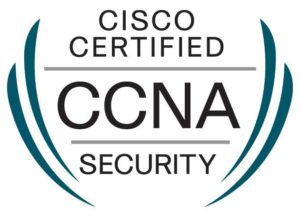
Exam Name: Impl Cisco Network Security Exam (210-260)(IINS v3.0 )
CCNA Security
The Implementing Cisco Network Security (IINS) v3.0 e-learning course focuses on security principles and technologies using Cisco security products to provide examples.
It allows you to understand common security concepts and deploy basic security techniques utilizing a variety of popular security appliances within a “real-life” network infrastructure.
You will gain valuable hands on experience through extensive live lab exercises. The live labs utilize sophisticated topologies which include IOS routers, IOS switches, Cisco Adaptive Security Appliances and Windows and Linux hosts. The course includes many learning oriented discovery labs. The discovery labs not only show the learner what to do, but explain why the technologies are important and demonstrate the results of the implementations.
It also includes 10 challenge labs. The challenge labs offer the opportunity to the learner to demonstrate that they can apply the concepts learned in the discovery labs. The challenge labs provide scenario requirements and automated grading functions. You will earn badges upon successful completion of challenge labs and challenge exercises.
Upon completing this course, you will be able to meet these overall objectives:
- Describe common network security concepts, Secure routing and switching infrastructure, Deploy basic authentication, authorization and accounting services,Deploy basic firewalling services,Deploy basic site-to-site and remote access VPN services,Describe the use of more advanced security services such as intrusion protection, content security and identity management.
Target Audience
- Network Security Specialist
- Security Technician
- Security Administrator
- Network Security Support Engineer
- Principle System Engineers
- Cisco Channel Partners
Prerequisites
A valid CCENT or a valid CCNA Routing and Switching or any CCIE certification can act as a prerequisite.
Exams
Required Exam(s) 210-260 IINS
Course Outline
1.0 Security Concepts
1.1 Common security principles
1.1.a Describe confidentiality, integrity, availability (CIA)
1.1.b Describe SIEM technology
1.1.c Identify common security terms
1.1.d Identify common network security zones
1.2 Common security threats
1.2.a Identify common network attacks
1.2.b Describe social engineering
1.2.c Identify malware
1.2.d Classify the vectors of data loss/exfiltration
1.3 Cryptography concepts
1.3.a Describe key exchange
1.3.b Describe hash algorithm
1.3.c Compare and contrast symmetric and asymmetric encryption
1.3.d Describe digital signatures, certificates, and PKI
1.4 Describe network topologies
1.4.a Campus area network (CAN)
1.4.b Cloud, wide area network (WAN)
1.4.c Data center
1.4.d Small office/home office (SOHO)
1.4.e Network security for a virtual environment
2.0 Secure Access
2.1 Secure management
2.1.a Compare in-band and out-of band
2.1.b Configure secure network management
2.1.c Configure and verify secure access through SNMP v3 using an ACL
2.1.d Configure and verify security for NTP
2.1.e Use SCP for file transfer
2.2 AAA concepts
2.2.a Describe RADIUS and TACACS+ technologies
2.2.b Configure administrative access on a Cisco router using TACACS+
2.2.c Verify connectivity on a Cisco router to a TACACS+ server
2.2.d Explain the integration of Active Directory with AAA
2.2.e Describe authentication and authorization using ACS and ISE
2.3 802.1X authentication
2.3.a Identify the functions 802.1X components
2.4 BYOD
2.4.a Describe the BYOD architecture framework, www.logiccalicut.com
2.4.b Describe the function of mobile device management (MDM)
3.0 VPN
3.1 VPN concepts
3.1.a Describe IPsec protocols and delivery modes (IKE, ESP, AH, tunnel mode, transport mode)
3.1.b Describe hairpinning, split tunneling, always-on, NAT traversal
3.2 Remote access VPN
3.2.a Implement basic clientless SSL VPN using ASDM
3.2.b Verify clientless connection
3.2.c Implement basic AnyConnect SSL VPN using ASDM
3.2.d Verify AnyConnect connection
3.2.e Identify endpoint posture assessment
3.3 Site-to-site VPN
3.3.a Implement an IPsec site-to-site VPN with pre-shared key authentication on Cisco routers and ASA firewalls
3.3.b Verify an IPsec site-to-site VPN
4.0 Secure Routing and Switching
4.1 Security on Cisco routers
4.1.a Configure multiple privilege levels
4.1.b Configure Cisco IOS role-based CLI access
4.1.c Implement Cisco IOS resilient configuration
4.2 Securing routing protocols
4.2.a Implement routing update authentication on OSPF
4.3 Securing the control plane
4.3.a Explain the function of control plane policing
4.4 Common Layer 2 attacks
4.4.a Describe STP attacks
4.4.b Describe ARP spoofing
4.4.c Describe MAC spoofing
4.4.d Describe CAM table (MAC address table) overflows
4.4.e Describe CDP/LLDP reconnaissance
4.4.f Describe VLAN hopping
4.4.g Describe DHCP spoofing
4.5 Mitigation procedures
4.5.a Implement DHCP snooping
4.5.b Implement Dynamic ARP Inspection
4.5.c Implement port security
4.5.d Describe BPDU guard, root guard, loop guard
4.5.e Verify mitigation procedures
4.6 VLAN security
4.6.a Describe the security implications of a PVLAN
4.6.b Describe the security implications of a native VLAN
5.0 Cisco Firewall Technologies
5.1 Describe operational strengths and weaknesses of the different firewall technologies
5.1.a Proxy firewalls
5.1.b Application firewall
5.1.c Personal firewall
5.2 Compare stateful vs. stateless firewalls
5.2.a Operations
5.2.b Function of the state table
5.3 Implement NAT on Cisco ASA 9.x
5.3.a Static
5.3.b Dynamic
5.3.c PAT
5.3.d Policy NAT
5.3 e Verify NAT operations
5.4 Implement zone-based firewall
5.4.a Zone to zone
5.4.b Self zone
5.5 Firewall features on the Cisco Adaptive Security Appliance (ASA)
5.5.a Configure ASA access management
5.5.b Configure security access policies
5.5.c Configure Cisco ASA interface security levels
5.5.d Configure default Cisco Modular Policy Framework (MPF)
5.5.e Describe modes of deployment (routed firewall, transparent firewall)
5.5.f Describe methods of implementing high availability
5.5.g Describe security contexts
5.5.h Describe firewall services
6.0 IPS
6.1 Describe IPS deployment considerations
6.1.a Network-based IPS vs. host-based IPS
6.1.b Modes of deployment (inline, promiscuous – SPAN, tap)
6.1.c Placement (positioning of the IPS within the network)
6.1.d False positives, false negatives, true positives, true negatives
6.2 Describe IPS technologies
6.2.a Rules/signatures
6.2.b Detection/signature engines
6.2.c Trigger actions/responses (drop, reset, block, alert, monitor/log, shun)
6.2.d Blacklist (static and dynamic)
7.0 Content and Endpoint Security
7.1 Describe mitigation technology for email-based threats
7.1.a SPAM filtering, anti-malware filtering, DLP, blacklisting, email encryption
7.2 Describe mitigation technology for web-based threats
7.2.a Local and cloud-based web proxies
7.2.b Blacklisting, URL filtering, malware scanning, URL categorization, web application filtering, TLS/SSL decryption
7.3 Describe mitigation technology for endpoint threats
7.3.a Anti-virus/anti-malware
7.3.b Personal firewall/HIPS
7.3.c Hardware/software encryption of local data
7.3.d Advanced Security concepts
